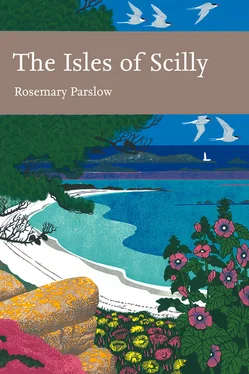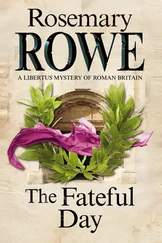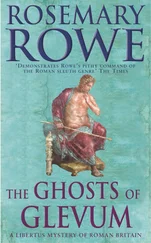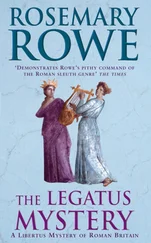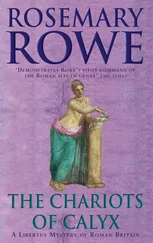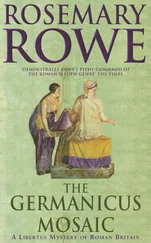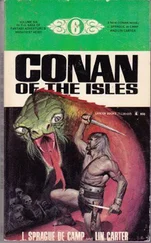South of the deep bay of Porth Hellick lies the open heathland of Salakee Down with the rather eroded outline of Giant’s Castle, an Iron Age hill fort. At Salakee Down is a beautiful stretch of coastal grassland and waved heath, again with common gorse and western gorse, bell heather, ling and other heathland species (Fig. 32). Close to the Giant’s Castle are a number of small damp and seasonally waterlogged pits with wetland plants including lesser spearwort Ranunculus flammula , bulbous Juncus bulbosus and soft rushes J. effusus as well as small adder’s-tongue fern Ophioglossum azoricum and royal fern Osmunda regalis . Further towards Porth Hellick are more areas of waved heath, where the heather is deeply channelled into ridges by the wind. These coastal areas are among the best places to look out for migrating birds, especially wheatears Oenanthe oenanthe , and even migrating butterflies such as clouded yellow Colias croceus . These ‘downs’ are also home to green tiger beetles Cicindela campestris , rose chafers Cetonia aurata and other insects.
Between Giant’s Castle and Blue Carn one of the runways of the airport
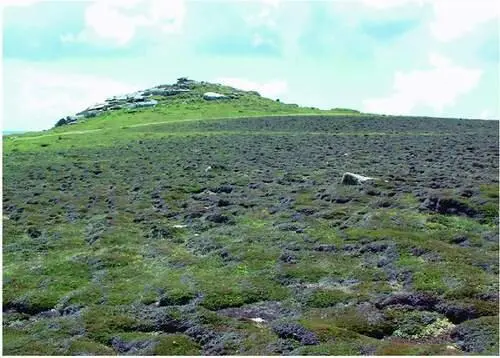
FIG 32.An example of ‘waved heath’ can be seen near Giant’s Castle, an Iron Age cliff castle. Salakee Down, June 2002. (Rosemary Parslow)
interposes itself into the cliff edge. Not a place to linger, although the system of traffic lights at the top of the slope on the edge of the cliff warns of the imminent approach or departure of aircraft. The airport is one of largest areas of open grassland on St Mary’s, but access is restricted due to safety considerations. Most galling for the birdwatchers, as the mown grass attracts rare plovers, wheatears and other birds of open habitats. Usually some kind of viewing place is negotiated each autumn so that birdwatchers can see part of the airfield without interfering with the business of flying.
As you round the corner into Old Town Bay you pass the narrow rocky promontory of Tolman Point, between the bay and Porth Minick. Here there are maritime grassland and cliff communities and a small triangular group of planted shrubs including shrubby orache Atriplex halimus . On the Old Town side of the headland Hottentot fig and rosy dewplant Drosanthemum roseum grow over the rocks and grassland, in places completely submerging native species.
The next headland round the coast is Peninnis Head, the southernmost point on St Mary’s (Fig. 33). This rocky promontory is important, with habitats that support rare plants and lichens. The impressive weathering of the granite tors and the lack of glacial features also contribute to the geological significance of the site. In the nineteenth century Peninnis ‘was considered one of the pleasantest places on the island by visitors; it was a large open downs with no hedge on the west side of it until you got halfway to Buzza Hill, and it was covered with long heath and wild flowers of various kinds which made it very pleasant in summer time’ (Maybee, 1883). The headland is still popular with visitors, who enjoy the dramatic scenery of massive granite carns eroded into natural sculptures and, among the rocks and tumbled boulders, the squat little lighthouse on the Head overlooking St Mary’s Sound. This is the place where the islanders have lit ceremonial bonfires in the past, and it was also the site for the Millennium beacon on 1 January 2000. There are the usual stretches of coastal grassland and maritime heath over the granite, with western clover Trifolium occidentale and two species uncommon elsewhere, spring squill Scilla verna and wild thyme Thymus polytrichus at one of its few Scilly locations. The most exposed edge of the headland is noted for its rare lichen flora including Ramelina siliquosa, Roccella fuciformis, R. phycopsis , golden hair-lichen Teloschistes flavicans and ciliate strap-lichen. To reach the Peninnis headland there is either the track around the coast or the central track from Hugh Town, King Edward’s Road, bisecting the cultivated centre of the headland, with arable fields and pastureland either side. The soils here are deep and less sandy than elsewhere
FIG 33.Peninnis Head is a jumble of extraordinary granite tors. May 2005. (Rosemary Parslow)
so a different range of arable weed species is found among the crop: these include some of the goosefoots Chenopodium spp. as well as the ubiquitous corn marigold Chrysanthemum segetum , docks Rumex spp., shepherd’s-purse Capsella bursa-pastoris and sow-thistles Sonchus spp.
Above Hugh Town is the high, rocky promontory of the Hugh, almost completely surrounded by the granite walls of the early fortifications of the Garrison. Here the long history of the Garrison is marked by an array of buildings, defence works and other structures. English Heritage manages most of the historic buildings and walls that form the Ancient Monument. There are some areas of semi-natural vegetation within the fortifications managed by the Wildlife Trust, mainly areas of bracken and bramble thickets, rough heathland and mown grassland. Some of the windbreaks of Monterey pine have died but there are still more pines and other trees on the eastern flank of the promontory. On the slopes of the hill Babington’s leek and balm-leaved figwort both grow among the bracken and bramble. And a few stands of the Nationally Scarce wild leek Allium ampeloprasum can also be found here, probably overlooked because they were assumed to be the commoner Babington’s leek variety. On the exposed southern side of the Garrison there are more maritime habitats from below the walls to the rocky shore (Fig. 34). There is also a row of tiny abandoned gardens perched on the edge of the cliffs. The thin soils on top of the massive granite walls often support a therophyte community (therophyte plants overwinter as seeds and germinate in spring) of dwarfed species of grasses and forbs similar to that seen on natural granite outcrops around the coast. Where they are permitted to flourish, small ferns such as sea spleenwort lodge in the mortar between the granite blocks, as do other plants that are usually found in rock crevices on the cliffs: Danish scurvygrass Cochlearia danica , pearlworts Sagina spp. and thrift Armeria maritima are frequent examples.
Other interesting species of ferns and other plants grow on both sides of the high granite walls. Between the ramparts are mown lawns that in some places are still typical of coastal grasslands with a tight sward of fescues Festuca spp., buck’s-horn plantain Plantago coronopus , sheep’s sorrel Rumex acetosella , small-flowered catchfly Silene gallica , western clover, rough clover Trifolium scabrum and other clovers. Besides the usual resident birds, the coastal area and the shelterbelts are good venues at bird migration times to look out for species such as wheatear, wryneck Jynx torquilla and black redstart Phoenicurus ochrurus . One section of wall near the Woolpack Battery is remarkable for the hundreds of autumn lady’s-tresses orchids Spiranthes spiralis that flourish there just at eye level in late summer.
FIG 34.Exposure to southern gales restricts growth on the seaward side of the Garrison walls to lichens, tiny ferns and a few other plants. November 2002. (Rosemary Parslow)
There are a number of former quarries on St Mary’s. Most are overgrown or incorporated into fields, and many are unlikely to be noticed. One you cannot miss is on the side of Buzza Hill. Rising up from Porth Cressa beach, the hill is a popular vantage point to look out over the town and beach below. The quarry at the foot of the hill is mainly used as an informal picnic or rest area and has a mixture of scrub and rough vegetation as well as grassland in the base. Among the plants that have colonised the walls of the quarry are Hottontot fig and another South African succulent, lesser sea-fig Erepsia heteropetala . Another unusual alien grass, rough dog’s-tail grass Cynosurus echinatus , also grows all along the sides of the track up the hill, usually with greater quaking-grass Briza maxima and tall stands of yellow and occasionally white sea radish Raphanus raphanistrum maritimus . Further up the hill yet another unusual alien called wireplant Muehlenbeckia complexa scrambles over the walls, covering most of the vegetation and even the ground with dense wirelike growths so it becomes a kind of mad sculpture. Once at the top of the hill you reach Buzza Tower (a former windmill restored to commemorate a visit by King Edward VII), surrounded by scrub, tall grasses and herbs. The shrubs include broom (probably native here) as well as gorse and bramble.
Читать дальше
